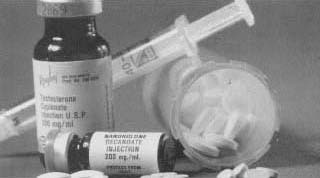Steroids
People usually think of steroids as drugs that athletes take to build their bodies more quickly. Steroids are more than that. They form an organic compound group that include sterols, D vitamins, bile acids, some hormones, saponins, glucosides (organic compounds that produce sugar) of digitalis, and some carcinogenic (cancer-causing) substances. These compounds may come from a number of different substances and have a variety of functions.
Cholesterol
Sterols, for example, are related to fats and are found in either plants or animals. An common example of a sterol is cholesterol. Cholesterol is found in almost all body tissues, particularly the nervous system, liver, kidneys

Other Steroid Group Members
Saponins are found in the roots of some plants. They can be very dangerous since they can destroy red blood cells. The steroid digitalis is a plant product used to stimulate the heart. It is a dangerous drug that must be administered with care because an overdose can be fatal. Sex hormones that control sexual maturity and reproduction are also steroids. Sex hormones include androgens for male functions and estrogens and progesterone for female functions.
[See also Sex hormones ; Vitamin ]
Comment about this article, ask questions, or add new information about this topic: